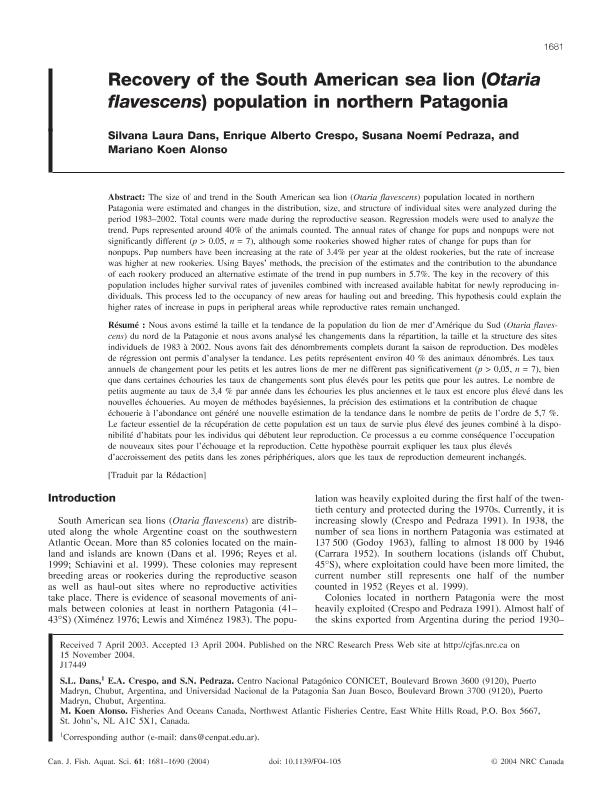Mostrar el registro sencillo del ítem
dc.contributor.author
Dans, Silvana Laura

dc.contributor.author
Crespo, Enrique Alberto

dc.contributor.author
Pedraza, Susana Noemi

dc.contributor.author
Koen Alonso, Mariano

dc.date.available
2020-05-06T18:26:49Z
dc.date.issued
2004-09
dc.identifier.citation
Dans, Silvana Laura; Crespo, Enrique Alberto; Pedraza, Susana Noemi; Koen Alonso, Mariano; Recovery of the South American sea lion ( Otaria flavescens ) population in northern Patagonia; National Research Council Canada-NRC Research Press; Canadian Journal Of Fisheries And Aquatic Sciences; 61; 9; 9-2004; 1681-1690
dc.identifier.issn
0706-652X
dc.identifier.uri
http://hdl.handle.net/11336/104386
dc.description.abstract
The size of and trend in the South American sea lion (Otaria flavescens) population located in northern Patagonia were estimated and changes in the distribution, size, and structure of individual sites were analyzed during the period 1983–2002. Total counts were made during the reproductive season. Regression models were used to analyze the trend. Pups represented around 40% of the animals counted. The annual rates of change for pups and nonpups were not significantly different (p > 0.05, n = 7), although some rookeries showed higher rates of change for pups than for nonpups. Pup numbers have been increasing at the rate of 3.4% per year at the oldest rookeries, but the rate of increase was higher at new rookeries. Using Bayes’ methods, the precision of the estimates and the contribution to the abundance of each rookery produced an alternative estimate of the trend in pup numbers in 5.7%. The key in the recovery of this population includes higher survival rates of juveniles combined with increased available habitat for newly reproducing in-dividuals. This process led to the occupancy of new areas for hauling out and breeding. This hypothesis could explain the higher rates of increase in pups in peripheral areas while reproductive rates remain unchanged.
dc.description.abstract
Nous avons estimé la taille et la tendance de la population du lion de mer d’Amérique du Sud (Otaria flavescens) du nord de la Patagonie et nous avons analysé les changements dans la répartition, la taille et la structure des sites individuels de 1983 à 2002. Nous avons fait des dénombrements complets durant la saison de reproduction. Des modèles de régression ont permis d’analyser la tendance. Les petits représentent environ 40 % des animaux dénombrés. Les taux annuels de changement pour les petits et les autres lions de mer ne diffèrent pas significativement (p > 0,05, n = 7), bien que dans certaines échouries les taux de changements sont plus élevés pour les petits que pour les autres. Le nombre de petits augmente au taux de 3,4 % par année dans les échouries les plus anciennes et le taux est encore plus élevé dans les nouvelles échoueries. Au moyen de méthodes bayésiennes, la précision des estimations et la contribution de chaque échouerie à l’abondance ont généré une nouvelle estimation de la tendance dans le nombre de petits de l’ordre de 5,7 %. Le facteur essentiel de la récupération de cette population est un taux de survie plus élevé des jeunes combiné à la disponibilité d’habitats pour les individus qui débutent leur reproduction. Ce processus a eu comme conséquence l’occupation de nouveaux sites pour l’échouage et la reproduction. Cette hypothèse pourrait expliquer les taux plus élevés d’accroissement des petits dans les zones périphériques, alors que les taux de reproduction demeurent inchangés.
dc.format
application/pdf
dc.language.iso
eng
dc.publisher
National Research Council Canada-NRC Research Press

dc.rights
info:eu-repo/semantics/openAccess
dc.rights.uri
https://creativecommons.org/licenses/by-nc-sa/2.5/ar/
dc.subject.classification
Ecología

dc.subject.classification
Ciencias Biológicas

dc.subject.classification
CIENCIAS NATURALES Y EXACTAS

dc.title
Recovery of the South American sea lion ( Otaria flavescens ) population in northern Patagonia
dc.type
info:eu-repo/semantics/article
dc.type
info:ar-repo/semantics/artículo
dc.type
info:eu-repo/semantics/publishedVersion
dc.date.updated
2020-04-27T14:43:34Z
dc.journal.volume
61
dc.journal.number
9
dc.journal.pagination
1681-1690
dc.journal.pais
Canadá

dc.journal.ciudad
Otawa
dc.description.fil
Fil: Dans, Silvana Laura. Consejo Nacional de Investigaciones Científicas y Técnicas. Centro Científico Tecnológico Conicet - Centro Nacional Patagónico; Argentina
dc.description.fil
Fil: Crespo, Enrique Alberto. Consejo Nacional de Investigaciones Científicas y Técnicas. Centro Científico Tecnológico Conicet - Centro Nacional Patagónico; Argentina
dc.description.fil
Fil: Pedraza, Susana Noemi. Consejo Nacional de Investigaciones Científicas y Técnicas. Centro Científico Tecnológico Conicet - Centro Nacional Patagónico; Argentina
dc.description.fil
Fil: Koen Alonso, Mariano. Consejo Nacional de Investigaciones Científicas y Técnicas; Argentina. Fisheries And Ocean Canada; Canadá
dc.journal.title
Canadian Journal Of Fisheries And Aquatic Sciences

dc.relation.alternativeid
info:eu-repo/semantics/altIdentifier/doi/http://dx.doi.org/10.1139/f04-105
dc.relation.alternativeid
info:eu-repo/semantics/altIdentifier/url/https://www.nrcresearchpress.com/doi/10.1139/f04-105#.XrMA4p5KiM8
Archivos asociados
